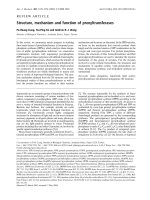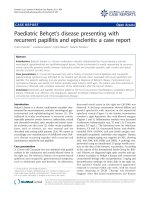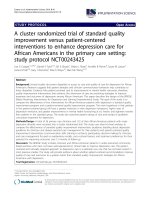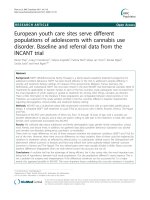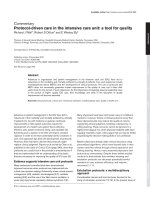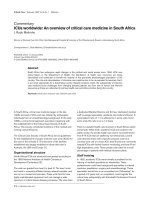Báo cáo y học: "Paediatric intensive care: out of commission" docx
Bạn đang xem bản rút gọn của tài liệu. Xem và tải ngay bản đầy đủ của tài liệu tại đây (28.48 KB, 2 trang )
PIM = Paediatric Index of Mortality.
Available online />It was recently revealed that one quarter of paediatric
intensive care beds in Holland are closed [1] and that many
critically ill children have to be transferred to receive care.
This is not an exclusively Dutch problem. Problems
organizing paediatric intensive care exist in most health care
systems. If we are to avoid crises such as this then we have
to solve two fundamental problems: the way in which we staff
the intensive care units with nurses; and the lack of
information that we have regarding the service that we are
trying to commission.
Nurse recruitment, retention and funding
Paediatric intensive care nurses are a scarce resource for a
number of reasons. First, they are usually required to have
specific higher postgraduate training in order to work at a
basic grade. Such training may not enhance their pay as
compared with other nurses in other disciplines. Second,
their career structure is pyramidal, which limits the
opportunities for individual progression and increases the
appeal of lateral career moves into less stressful
environments such as community nursing or (in the UK)
National Health Service direct. From the nurse’s perspective,
salary progression is usually linked purely to administrative
responsibility and often fails to recognise significant
additional practical and intellectual skills, such as intensive
care training itself or additional experience (e.g. in techniques
such as haemofiltration or extracorporeal membrane
oxygenation). Even when additional recurrent funds are
identified to commission a paediatric intensive care service, it
can thus prove prohibitively difficult to open intensive care
beds. Furthermore, when service provision is inadequate,
problems with recruitment suffer from negative reinforcement.
Jobs in a stressed service are inevitably anticipated to be
stressful themselves.
There is no single answer to this problem. Centralization of
care in large high volume units enables the best return from
any limited resource, and it is tempting to assume that nurses
will be the same as any other resource in this respect. The
impact of centralization on nurse recruitment, however, has
not been determined. Nurses are unlikely to commute large
distances to find work in intensive care in preference to a
local change in specialty.
Lack of information
Effective planning and commissioning of a paediatric
intensive care service requires close audit of activity, which
we lack. In many cases this lack of information conceals
variation in resource provision and differences in
performance. The required information is naturally specific.
The capacity of a paediatric intensive care service can be
described in terms of the number of physical bed spaces
Commentary
Paediatric intensive care: out of commission
Gale A Pearson
Head of Specialty (Paediatric Intensive care), Birmingham Childrens Hospital, Steelhouse Lane, Birmingham, UK
Correspondence: Gale A Pearson,
Published online: 9 July 2002 Critical Care 2002, 6:387-388
This article is online at />© 2002 BioMed Central Ltd (Print ISSN 1364-8535; Online ISSN 1466-609X)
Abstract
Problems with commissioning paediatric intensive care stem both from difficulties in recruitment and
retention of nurses, and from incoherent or nonexistent national audit. Pyramidal career structures and
patterns of remuneration that concentrate on administrative responsibility over clinical skills underlie
the former, whereas poor audit conceals variations in both service quality and demand.
Epidemiologically superior data are required if we are to solve commissioning problems. We need to
know what happened to every child from a defined population receiving intensive care and whether a
lack of resources means that some children are denied intensive care.
Keywords audit, epidemiology, intensive, nursing, paediatric
Critical Care October 2002 Vol 6 No 5 Pearson
present, but this does not reassure us that the beds are
accessible. Variations in patient dependency, the numbers of
nurses available and their skill mix all have to be taken into
account when deciding whether a bed can be used at a
given time. Even knowledge of the number of accessible
beds tells us nothing about the amount of work being done.
Such information can only be gained by looking at patient
flow (admission rate, duration of stay, occupancy,
readmission rate) and intervention rates. Even then,
information regarding quality of care is lacking.
A limited view of the quality of care (its effectiveness) can be
inferred from standardized mortality ratios generated using
mortality prediction models. There are in essence two such
models available for paediatrics [2,3]. They have
considerable differences and are not universally applied.
However, the use of mortality data in this way has been
questioned in paediatric intensive care, where survival rates
are greater than 90% and morbidity may be of increased
relevance because of the potential longevity of survivors.
Most literature and research using standardized mortality is
based on the performance of individual units or groups of
units. From an epidemiological perspective, however, it is
preferable to know what happened to every child from a
defined population who received intensive care (irrespective
of where it was provided) and whether a lack of resources
meant that some children were denied intensive care [4].
Change and variation in standards
There is evidence that increasing numbers of children are
receiving or are expected to receive intensive care. In the UK
(or at least in Birmingham [5]) this is occurring without a
change in the intubation rate, implying that the change could
represent partial resolution of an asserted shortage [6,7].
Alternatively, the clinical threshold for intervention (intubation)
is falling. Paediatric intensive care space is used as it
becomes available. Where there are ample resources there is
a tendency to provide high dependency care and
‘observation’ on the intensive care unit, whereas triage
otherwise limits this tendency. Hence, when great variation in
the incidence of intubation is observed within [8] or between
[9] health care systems, one can infer variation in resource
provision. The greatest concern must be when refused
admissions occur in units with high intubation rates. The
appropriateness of intensive care admission or intervention
ultimately still has to be judged on a case review basis.
Comprehensive audit
The development of the mortality prediction model ‘PIM’
(Paediatric Index of Mortality) [2] has involved a collaboration
that has, among others, incorporated all paediatric intensive
care delivered in Australia. The epidemiological superiority of
these data will increase the influence of the conclusions
drawn from it. In the UK, where we have long suffered from
similar problems to those currently affecting Holland [1],
some centres are also contributing to the PIM collaboration
[8]. However, a system for centralized audit is also being
established. First, this is being achieved through a study
designed to assess the relevant mortality prediction models,
which is to include morbidity (United Kingdom Paediatric
Intensive Care Outcome Study, UKPICOS) [10]. The study
has recruited all the major providers of paediatric intensive
care in the UK. Second, the English Department of Health
has commissioned a continuous audit of paediatric intensive
care to follow on from that study called ‘PICANET’
(Paediatric Intensive care Audit Network), which will include
the successful severity model. Hence, commissioners will
have access to comparative, risk adjusted, performance data
on which to make their decisions. All we have to do now is
pay the nurses what they are worth!
Competing interests
None declared.
References
1. Sheldon T: Quarter of Dutch paediatric intensive care beds
closed [letter]. BMJ 2002, 324:259.
2. Shann F, Pearson G, Slater A, Wilkinson K: Paediatric index of
mortality (PIM): a mortality prediction model for children in
intensive care. Intensive Care Med 1997, 23:201-207.
3. Pollack MM, Patel KM, Ruttimann UE: PRISM III: an updated
Pediatric Risk of Mortality score. Crit Care Med 1996, 24:743-
752.
4. Shann F: Where do all the children go? Intensive Care Med
2000, 26:6-7.
5. Pearson G, Barry P, Timmins C, Stickley J, Hocking M: Changes
in the profile of paediatric intensive care associated with cen-
tralisation. Intensive Care Med 2001, 27:1670-1673.
6. Shann F: Paediatric intensive care [letter]. Lancet 1993, 342:
1240.
7. Shann F: Australian view of paediatric intensive care in Britain.
Lancet 1993, 342:68.
8. Pearson GA, Stickley J, Shann F: Calibration of the paediatric
index of mortality in UK paediatric intensive care units. Arch
Dis Child 2001, 84:125-128.
9. Angus DC, Sirio CA, Clermont G, Bion J: International compar-
isons of critical care outcome and resource consumption. Crit
Care Clin 1997, 13:389-407.
10. Parry G, Jones S, Simic-Lawson M: Calibration of the paediatric
index of mortality in UK paediatric intensive care units [letter].
Arch Dis Child 2002, 86:65.
